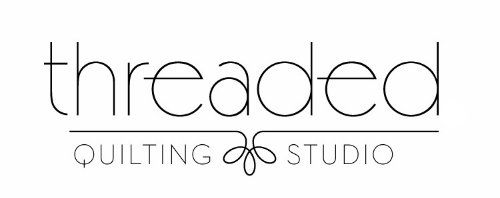I'm a gal who enjoys using the materials I have and don't get "fancy" very often.
Because of this irritating characteristic, I tend to make things hard on myself. I'm also kiiiiiiind of stubborn. I once went something like 9 years without changing my rotary cutter blade whilst having a set of 5 replacement blades in a drawer. Yeah... not even kidding or exaggerating.
I consider having a working rotary blade "fancy". (Not really.)
Do you still want to take advice from me? HA! Ruuuuuuuuuuunnnnnnnnn!
For those of you still reading, I wanted to tell you about my recent experimentation with using tracing paper for foundation piecing paper.
Let me back up just a tad: I have most often used regular copy or printer paper for foundation piecing. There are pros and cons to doing this. One pro is that it's readily available and I typically have it at home. Another pro is that when tearing away, it usually rips off in fairly big chunks. On the con side of things, when tearing away, the thickness can cause stress on my stitches even when using a shortened stitch length. Another con is that it's less flexible. In my current project, I'm y-seaming the paper foundations after sewing the pieced sections. Regular copy paper is more rigid and thicker to pin through.
At a retreat at my friend Mandy's house, she was generous enough to let me use the paper she had on hand for foundation paper piecing. It was from a kids drawing pad that she picked up at Hobby Lobby (in the kids art supply section), 100 pages for $1.99. Here's a picture:
Because the sheets were slightly larger than a standard letter size, I trimmed them down first to 8.5" x 11" before feeding them through her printer. It was so easy to do. The paper was thin and ended up being lovely to sew upon.
About six months later, when I finally got around to going to my nearest Hobby Lobby (I hate to shop), I found they didn't have the same notepads. They did have tracing paper in the kids section that I bought instead. I don't really know how it compares in weight to the newsprint that is used in the "scribble and rubbing pad" shown above. I'd guess it's perhaps a little thinner.
If you'll notice (I didn't at the time), this isn't as good of a deal financially speaking, only getting about 13 pages to the dollar. I used the standard 40% off Hobby Lobby coupon for a higher priced item and therefore didn't get a discount on this tracing paper. One product I may try in the future is this newsprint on Amazon Prime. It has pretty great reviews for foundation paper piecing. Delivery included is a big plus for this store-avoider. At the time of this posting, the price of the newsprint would yield over 30 pages to the dollar AND I wouldn't have to cut it down to size.
Back to the tracing paper: When I got it home and tried printing a block on it, it performed miserably in my printer. Like, none of the pages I attempted would go through without getting mangled beyond belief.
I did a little bit of legwork so that I could still use this tracing paper. I ironed it to the waxy side of freezer paper to give it more body, cut it down to 8.5" x 11" size, put it in my printer tray (one at a time) and it printed beautifully! I could use the freezer sheets more than once, re-pressing them to new sheets of tracing paper and putting them in my printer tray.
Only later did I discover that my laser printer (not an inkjet printer, BTW) has a manual tray for feeding sheets one at a time. This is different than putting a single sheet into the paper tray (which is what I had been doing). I tried the manual tray with much hope, but alas, I did not get a single sheet to print without wrinkling it beyond use.
But I didn't give up! On a whim, I placed a regular piece of paper behind a single tracing paper and fed them through the manual feed at the same time. Remarkably, it worked! I'll be totally honest that in my experience thus far, I've had about 75% success with this method. Occasionally, it doesn't work. I found that with my printer—which is a Brother DCP-7065DN—I had to use a new, "unused" sheet of printer paper as the "backer" each time. After it went through once, the paper developed a slight bend to it (or maybe it's static electricity?) that prevented a successful second pass through the printer with a new tracing paper.
So all in all, is this method SUPER-temperamental? Yes. Perfect? Heck no. Worth a shot in order to not waste this dadgum tracing paper? I think so! Plus, it's pretty exciting while you're waiting to find out if it'll work! :) The suspense = PRO!



